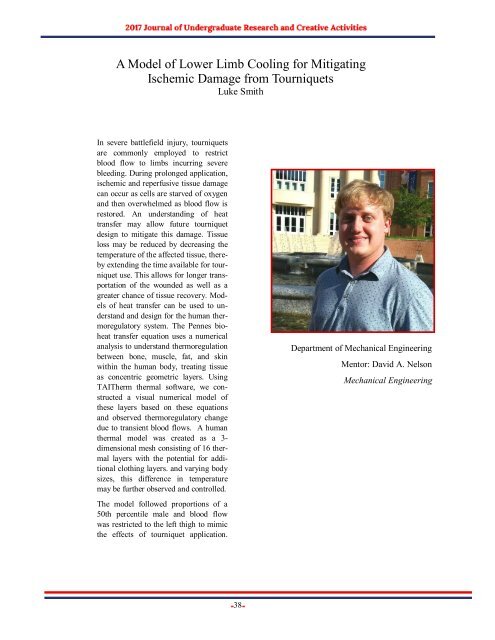JOURACA_SP_2017
You also want an ePaper? Increase the reach of your titles
YUMPU automatically turns print PDFs into web optimized ePapers that Google loves.
A Model of Lower Limb Cooling for Mitigating<br />
Ischemic Damage from Tourniquets<br />
Luke Smith<br />
In severe battlefield injury, tourniquets<br />
are commonly employed to restrict<br />
blood flow to limbs incurring severe<br />
bleeding. During prolonged application,<br />
ischemic and reperfusive tissue damage<br />
can occur as cells are starved of oxygen<br />
and then overwhelmed as blood flow is<br />
restored. An understanding of heat<br />
transfer may allow future tourniquet<br />
design to mitigate this damage. Tissue<br />
loss may be reduced by decreasing the<br />
temperature of the affected tissue, thereby<br />
extending the time available for tourniquet<br />
use. This allows for longer transportation<br />
of the wounded as well as a<br />
greater chance of tissue recovery. Models<br />
of heat transfer can be used to understand<br />
and design for the human thermoregulatory<br />
system. The Pennes bioheat<br />
transfer equation uses a numerical<br />
analysis to understand thermoregulation<br />
between bone, muscle, fat, and skin<br />
within the human body, treating tissue<br />
as concentric geometric layers. Using<br />
TAITherm thermal software, we constructed<br />
a visual numerical model of<br />
these layers based on these equations<br />
and observed thermoregulatory change<br />
due to transient blood flows. A human<br />
thermal model was created as a 3-<br />
dimensional mesh consisting of 16 thermal<br />
layers with the potential for additional<br />
clothing layers. and varying body<br />
sizes, this difference in temperature<br />
may be further observed and controlled.<br />
Department of Mechanical Engineering<br />
Mentor: David A. Nelson<br />
Mechanical Engineering<br />
The model followed proportions of a<br />
50th percentile male and blood flow<br />
was restricted to the left thigh to mimic<br />
the effects of tourniquet application.<br />
38

















